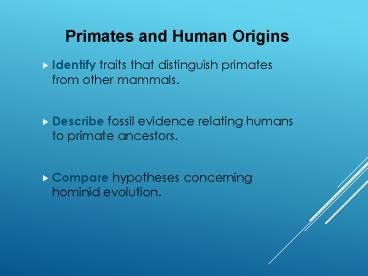Identify traits that distinguish primates from other mammals. - PowerPoint PPT Presentation
1 / 18
Title:
Identify traits that distinguish primates from other mammals.
Description:
Primates and Human Origins Identify traits that distinguish primates from other mammals. Describe fossil evidence relating humans to primate ancestors. – PowerPoint PPT presentation
Number of Views:166
Avg rating:3.0/5.0
Title: Identify traits that distinguish primates from other mammals.
1
Primates and Human Origins
- Identify traits that distinguish primates from
other mammals. - Describe fossil evidence relating humans to
primate ancestors. - Compare hypotheses concerning hominid evolution.
2
Primates and Human Origins
- Characteristics
- Many primate characteristics are generalized
rather than specialized and are similar to
features possessed by ancestral mammals. - Many primate traits are adaptations for living in
groups in trees. - Examples include strong three-dimensional vision
and prehensile appendages, or hands, feet, and
tails that can grasp. - The primate brain, with its large cerebrum, is
able to interpret complex visual information and
keep track of subtle shifts in social
organization.
3
Primates and Human Origins
- Primate characteristics include
- Large brain parts relative to size
- Acute color vision
- Generalist teeth
- Communication
- Infant care
- Manual dexterity
- Social organization
- Characteristic skeletal structure
4
Primates and Human Origins
- Prosimians Anthropoids
- The primate lineages that evolved the earliest
include lemurs, lorises, and tarsierssometimes
referred to as prosimians. - The anthropoid primates include gibbons, New
World monkeys, Old World monkeys, and apes,
including humans. - Anthropoid adaptations include rotating shoulder
and elbow joints and an opposable thumb. - All anthropoids have a similar dental formula.
- Compared to other primates, anthropoids have a
more complex brain structure and a larger brain
relative to body size. - Orangutans, gorillas, chimpanzees, bonobos, and
humans make up the great apes.
5
Primates and Human Origins
- Modern Humans
- Among living mammals, only humans, Homo sapiens,
have the trait of bipedalism. - The human skeleton is adapted for bipedalism in
several ways. The bowl-shaped human pelvis
supports internal organs. - The human spine curves in an S shape.
- Human toes are aligned with each other and are
short. - The larger brain and smaller jaw in humans result
in a flatter face than that found in apes. - The human brain is capable of speech
communication.
6
Primates and Human Origins
- Hominids
- Hominids include humans and extinct humanlike
anthropoid species. - Bipedalism is the distinguishing characteristic
of this group. - Apelike ancestors of the first hominids were
probably quadrupedal. - Fossil evidence has provided some clues as to how
long ago the first bipedal hominid evolved.
7
Types of Primates
Primates and Human Origins
Click below to watch the Visual Concept.
Visual Concept
8
Primates and Human Origins
- Fossil Hominids
- Paleontologists and anthropologists have
concluded that a variety of humanlike species
lived on Earth within the past 10 million years.
9
Primates and Human Origins
- Australopithecines
- A number of fossils of bipedal anthropoid
primates with the brain size of a chimpanzee have
been discovered in parts of Africa and date from
about 2.5 million to 4 million years ago. - These organisms have been classified in the genus
Australopithecus within the subfamily of
australopithecines, which may include other
genera. - The first australopithecine fossil discovery,
nicknamed Lucy, was found in 1974 in the Afar
Valley region of Africa by Donald Johanson and
colleagues.
10
Primates and Human Origins
11
Comparing Gorillas and Australopithecine Skeletons
Primates and Human Origins
Click below to watch the Visual Concept.
Visual Concept
12
Primates and Human Origins
- Paleontologists continue to find new hominid
fossils and debate their classification. - It is clear that several hominid forms arose,
thrived, and became extinct over the past 7
million years. Different species may have
coexisted in time and possibly interacted.
13
Primates and Human Origins
- Early hominid species include
- Gracile (slender) australopithecines
- Australopithecus afarensis (Lucys species)
- A. anamensis
- A. africanus
- Robust australopithecines (may be genus
Paranthropus) - A. aethiopicus
- A. robustus
- A. boisei
14
Primates and Human Origins
- Sometime after australopithecines, the genus Homo
appeared. - Extinct and living members of this genus are
called humans. - Homo habilis and Homo erectus
- Homo habilis means the handy human.
- A later species was Homo erectus (meaning
upright human).
15
Primates and Human Origins
- Homo sapiens and Homo neanderthalensis
- Neanderthals, now classified as H.
neanderthalensis, lived in Europe and Asia from
about 230,000 to 30,000 years ago. - They may have interacted with H. sapiens in some
places. - The first humans classified as H. sapiens
appeared about 160,000 years ago. - Some early fossils of H. sapiens are referred to
as Cro-Magnons.
16
Primates and Human Origins
- Modern Humans
- Two major hypotheses have been proposed to
explain how modern humans come to occupy the
entire globe - In the multiregional hypothesis, local
populations of H. erectus gave rise to local
populations of H. sapiens all over the world. - In the recent-African-origin hypothesis, H.
sapiens evolved from H. erectus in Africa, then
migrated out of Africa and populated the globe. - An analysis of mitochondrial DNA from people
around the world suggests that humans did arise
in Africa.
17
Primates and Human Origins
18
Early Members of the Human Genus
Primates and Human Origins
Click below to watch the Visual Concept.
Visual Concept

